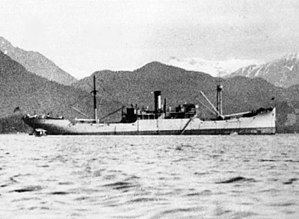Completed July 1920 Decommissioned 17 April 1946 Construction started 1920 Length 119 m Displacement 4.409 million kg | Acquired 8 November 1921 Struck 30 June 1946 Launched 5 June 1920 Weight 4,938 tons Draft 3.61 m | |
 | ||
Commissioned USS Arcturus (AK-12),
1 February 1922 Fate sold for scrapping, 1 December 1947 Builders Bethlehem Shipbuilding Corporation, Wilmington | ||
USS Gold Star (AK-12) was a cargo ship acquired by the U.S. Navy for service in World War II. She was responsible for delivering necessary goods and equipment to ships and stations in the war zone.
Contents
Renamed Gold Star
Gold Star (AK-12) was built in 1920 by Bethlehem Shipbuilding Corp., Wilmington, Delaware: taken over by the Navy as Arcturus from the USSB 8 November [1921]; commissioned as Arcturus (AK-12) 1 February 1922 at Philadelphia, Pennsylvania, Lt. Comdr. J. Katterfield, USNRF, in command and 5 days later renamed Gold Star (AK-12) on 6 February. The ship was reclassified AG-12, 12 May 1922.
Post-World War I operations
Renamed Gold Star sailed from Philadelphia 18 March 1922, arriving Seattle, Washington, 1 July via the Panama Canal Zone and California ports. During the next 2 years she served as a cargo ship on the U.S. West Coast, making three voyages with supplies for Alaskan radio stations. The ship steamed out of San Francisco, California, 9 October 1924 to assume her duties as station ship at Guam, arriving 3 November.
An Asia specialist
During the 1920s and 1930s Gold Star became a familiar sight in the far-flung ports of Asia. Though assigned as flagship of the US Navy at Guam she made frequent voyages to Japan, China, and the Philippines with cargo and passengers. Prior to World War II, much of her crew was made up of Chamorro, natives of Guam with American non-commissioned officers and commissioned officers.
The Gold Star became a bit of a veteran Q-Ship dealing with communications intelligence as she moved from port to port and while in port in the Orient. As a station ship she was assigned to monitor 1) Internal Japanese Fleet frequencies 2) Frequencies measurements and DF or direction finder azimuths. She had three intercept operators and one chief radioman supervised by an officer. This all started in 1933 during the reconstruction of the Japanese fleet by Tokyo and continued into the summer of 1941. The Gold Star along with ground stations in Guam, Olongapo and Beijing provided significant intelligence before the Japanese attack on Pearl Harbor on December 7, 1941.
In the Philippines when World War II started
When the Japanese attacked Pearl Harbor, 7 December 1941, Gold Star was coaling at Malangas, Philippine Islands. She sailed for Manila 8 December, but was ordered by Commander, Asiatic Fleet, to proceed to Balikpapan, Borneo. She arrived 14 December as the Japanese advanced quickly southward; and after issuing urgently needed provisions to units of the Asiatic Fleet there, steamed by way of Macassar, Celebes, to Darwin, Australia. Following her arrival at Darwin 28 December, Gold Star served as a coastal cargo carrier, steaming between such Australian ports as Brisbane, Sydney, and Fremantle. She thus contributed importantly to strengthening Australia and to checking the Japanese advance in New Guinea. After 15 August 1943 the veteran ship continued her coastal operations in Australia, but also began a series of cargo voyages to New Guinea and the Admiralty Islands. Gold Star brought many loads of vital supplies to Milne Bay as the Allies began the push toward the Philippines.
Supporting American invasion forces
The ship arrived Manus Island 6 January 1945 for repairs and conversion to squadron flagship for Service Squadron 9. Operating in this capacity the old ship supported the mounting American advance toward Japan, sailing to Leyte and Morotai. While conducting cargo operations at Morotai 28 June Gold Star was attacked by enemy aircraft but sustained no damage. She arrived Manila 26 July via Tawitawi and remained there issuing supplies until the surrender of Japan 15 August 1945.
End-of-war activity
After supporting occupation forces in Japan, Gold Star sailed to Seattle, Washington, in February 1946 and decommissioned there 17 April 1946. She had served over 21 years in the Western Pacific Ocean without once returning to the United States, and had carried countless tons of supplies, items large and small, for the warships of the fleet. The old ship was delivered to the Maritime Commission 30 June 1946, and was sold for scrap 1 December 1947 to Dulien Steel Products, Inc.
Military awards and honors
Gold Star received one battle star for World War II service. Her crew members were entitled to the following medals:
